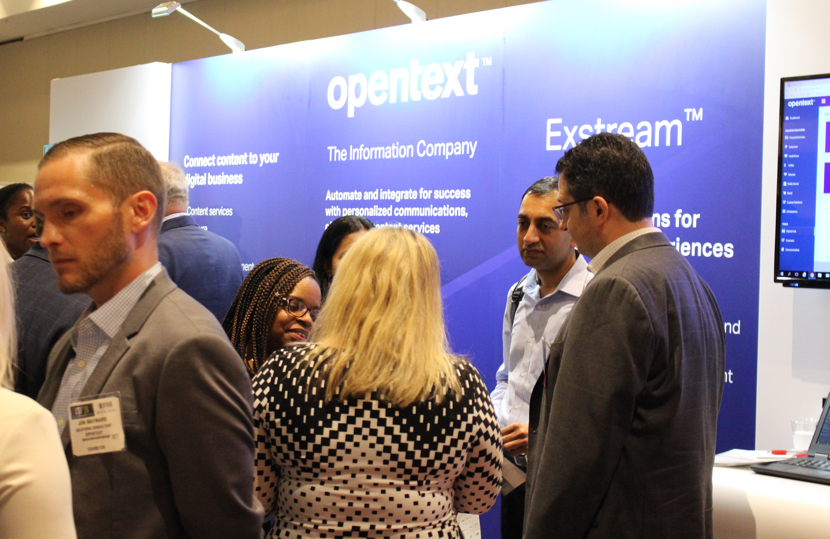
OpenText displays their recent Release 16 Enhancement Pack 4 (EP4) at DSF '18 in Boston on May 21.
OpenText is a behemoth provider of enterprise information management—well known for its habit of scooping up companies that match its particular skillset and market alignment, including some former competitors as well (such as the 2016 acquisition of HP Exstream and the 2017 deal for Dell EMC's Enterprise Content Division and Documentum). In fact, the Waterloo-based company has acquired 18 different sets of products since 2004, after purchasing its flagship product in 1996 that evolved into OpenText Content Server. There’s no end in sight for its buying spree either, as OpenText CEO and CTO Mark Barrenechea reiterated their commitment to acquisitions as part of OpenText’s overall growth strategy as recently as late last month.
With a deep portfolio spanning digital asset management, information security, customer experience management, business process management, enterprise content management, business intelligence and analytics, there’s no question that OpenText has emerged as a significant platform player in recent years. At the same time, the sheer breadth of technologies and potential use cases offered by OpenText often leave many to wonder how all the pieces will fit together for a truly strategic solution within most organizations. While there’s been a lot of outside speculation, OpenText recently made their intentions pretty clear when I sat down with them at our annual event, DSF ’18, a couple of weeks ago.
“Obviously, we're seeing a lot of growth from Office 365,” says Stephen Ludlow, Senior Director of Enterprise Product Marketing at OpenText. (To be exact, there are now 135 million active Office 365 business users, according to Microsoft.) “Frankly, I want to be the other platform in every organization—the one for your digital business. That's really where I'd like to see OpenText in the future.”
The Digital Workplace, the Digital Business, and Connecting Your Content
As companies embark on their digital transformation journeys, these efforts typically fall into two main categories: the digital workplace and the digital business. According to Gartner, the digital workplace is characterized by specific use cases and high-value business moments (i.e., creating digital dexterity between employees, partners, and customers), while the digital business is about transforming digital operations and creating insight through content and data, thus, delivering business value.OpenText still has investments in the digital office and the productivity suite in particular (which was evident in their recent acquisition of cloud file sharing and collaboration company Hightail in February and the integration of its own cloud file sharing and collaboration app OpenText Core into Content Suite and Documentum), but Mr. Ludlow emphasized that they are increasingly focused on connecting content to the digital business and those applications where the digital business resides. “We're looking at transforming business processes into being digital business processes, and that doesn't just mean changing paper into electronic documents. We’re really looking at re-engineering those processes.”
This marked shift in focus may also be a result of the shrinking middle ground between the digital workplace and the digital business, as market consolidation is expected to continue. For now, OpenText has decided which camp they’re clearly invested in.
Information Evolves into Insight
Over the last couple of years, the content management industry has begun to push beyond the traditional concept of controlling and storing our content, no doubt spurred on by the demands of digital transformation. What good is content and data if we can’t use it to understand a problem or create new ideas and concepts? To drive these new digital business processes, we’re seeing the evolution of modern platform architectures that serve as the backbone on which new solutions are being built, increasingly powered by artificial intelligence (AI) to deliver insight and knowledge. According to IDC, “These platforms are frequently architected for the cloud and provide standard APIs and interfaces that enable partners and customers to construct purpose-built, best-of-breed solutions.”In a recent evaluation of OpenText’s platform approach to customer communications, Kaspar Roos, CEO of a technology advisory firm specializing in customer communications, said, “We are excited about OpenText’s vision to migrate its core products to a microservices architecture and develop an intelligent integration layer based on API-connectivity and Magellan AI orchestration technology. This enables OpenText to build custom solutions for its customers and deploy them through a (managed) cloud service.”
While OpenText is investing in REST APIs and shared services for cross-product integrations, Mr. Roos cautions that these “integrations do not change the current underlying architectures and look-and-feel of the various products.”
“Being a platform company is great, and platforms are important,” Mr. Ludlow told me. “But platforms are just technology, not problem solvers. We want to be a combination of both: to have all the benefits of a platform technology, which solves more than one problem per application, but also have applications that are really specific to certain business problems that our customers are trying to address.”
An example of this can be found in OpenText Experience Center, an application built upon the platform to solve some very specific problems. Part of the Experience Center is the rearchitected customer communications management (CCM) assets of HP Exstream, features from their Communications Center Enterprise (formerly StreamServe), and their Communications Center CRM (formerly PowerDocs), all combined under the rebranded product OpenText Exstream. Very recently, we’ve seen OpenText pivot toward the concept of omni-channel orchestration—a concept “aimed to understand the intent and context of communications.”
At its core, orchestration is about “orchestrating the experience and the journey across all channels based on the context of the interaction,” says Avi Greenfield, Senior Manager of Product Strategy at OpenText. It is here that we see perhaps the biggest payoff for OpenText in their complicated acquisition play to create a digital hub of sorts and their big investment in its AI and cognitive platform, Magellan, launched in 2017—a direct strike against IBM Watson.
After all, orchestration is all about using data analytics, machine learning, and AI to provide insight around business objectives. We’re already seeing OpenText embed the open source Magellan into OpenText Explore search (supported by natural language search processing capabilities) and integrations into Documentum, Content Server, Archive Center, and eDocs for content mining. OpenText describes Magellan as a set of components to connect to your content where it resides and to manipulate that data and derive insight from it. In its current iteration, Magellan is positioned to underscore their priorities in “extending” into applications of the digital business. However, as organizations worldwide focus more and more on insight, conversational interfaces (chatbots), and offloading the management of unstructured content, we can certainly expect to see Magellan transform into a full-fledged AI engine.
It’s a complicated mix of technologies, integrations, and services, as OpenText refocuses on transforming the digital business, but Mr. Greenfield says, “I think we have an understanding and appreciation of what takes place in the digital asset arena to help tie it all together and provide that complete view for the enterprise.”
In a broad sense, it seems OpenText is focused on balancing the needs of a platform and those applications that address specific line of business problems, all of which is filtered through the lens of insight and the evolving needs of its customers.
It’s a complicated mix of technologies, integrations, and services, as OpenText refocuses on transforming the digital business, but Mr. Greenfield says, “I think we have an understanding and appreciation of what takes place in the digital asset arena to help tie it all together and provide that complete view for the enterprise.”
In a broad sense, it seems OpenText is focused on balancing the needs of a platform and those applications that address specific line of business problems, all of which is filtered through the lens of insight and the evolving needs of its customers.
Allison Lloyd serves as the Editor of DOCUMENT Strategy Media. She delivers thought leadership on strategic and plan-based solutions for managing the entire document, communication, and information process. Follow her on Twitter @AllisonYLloyd.







